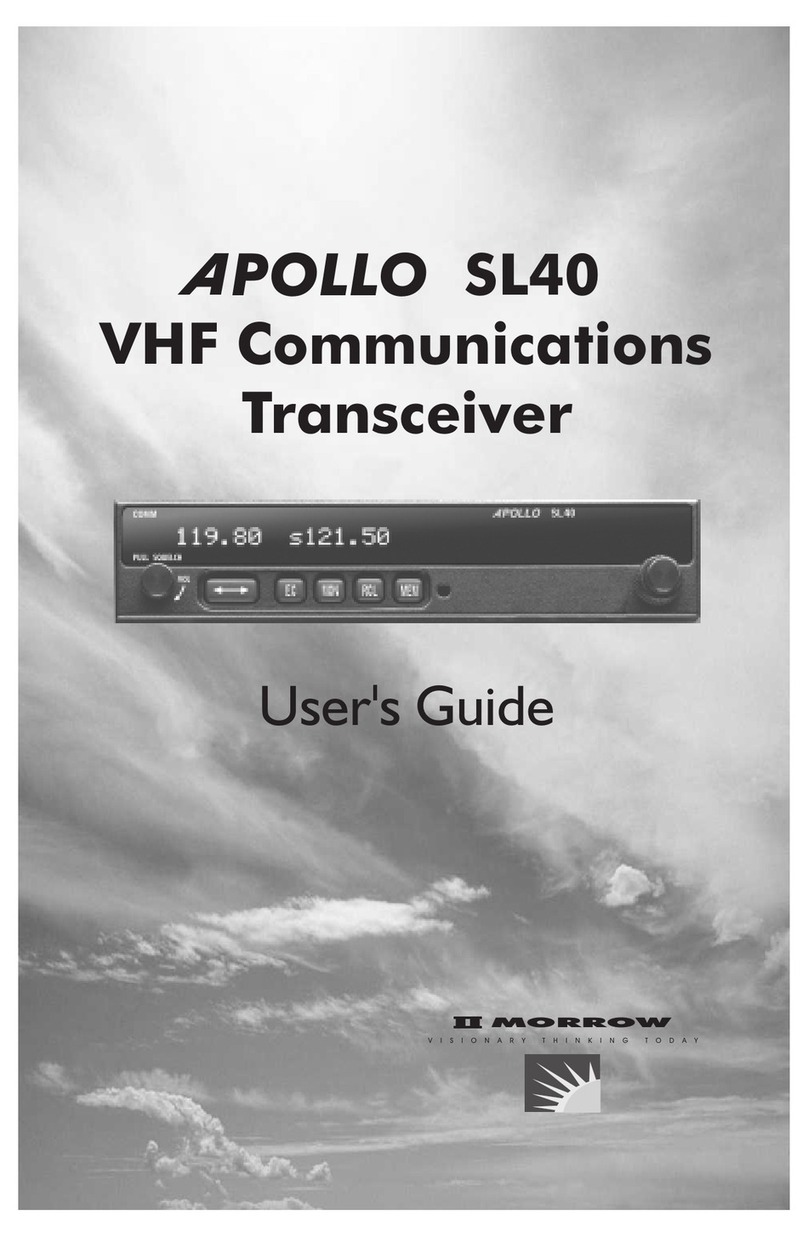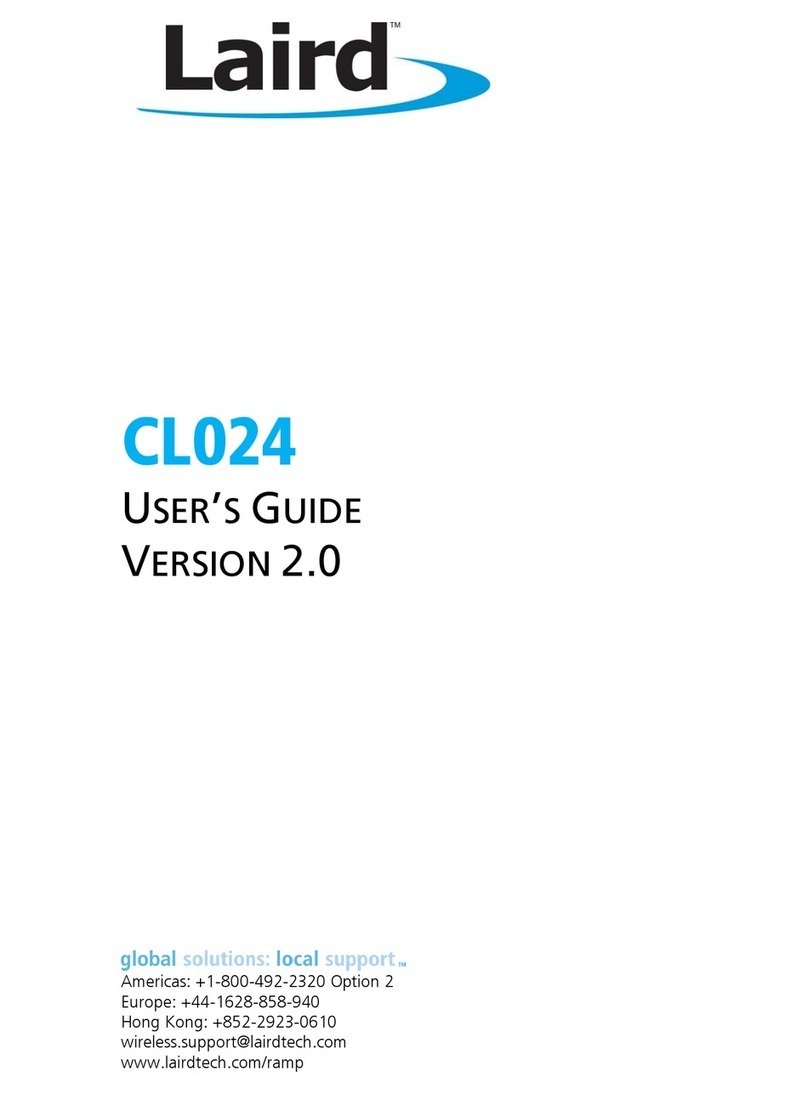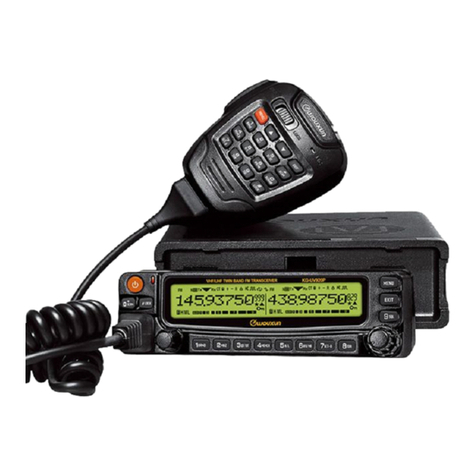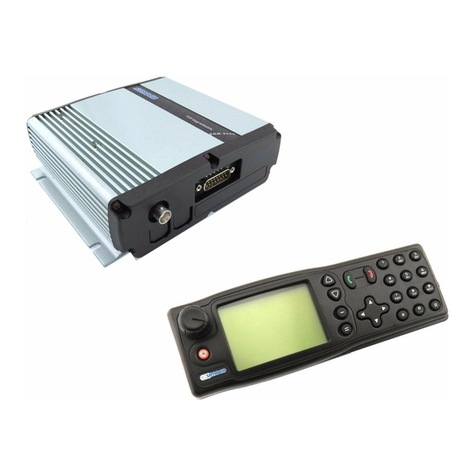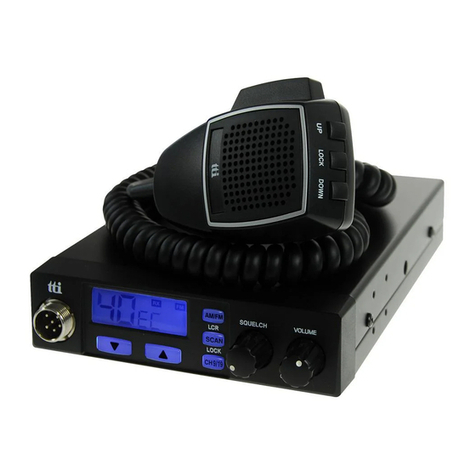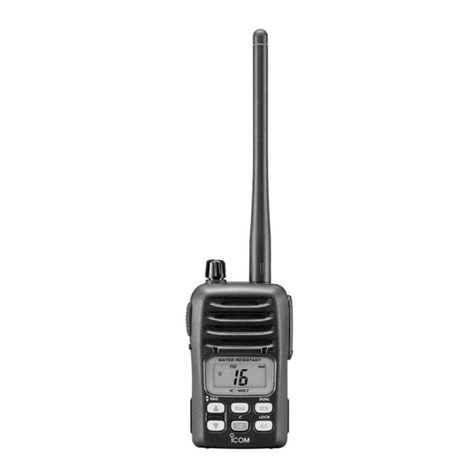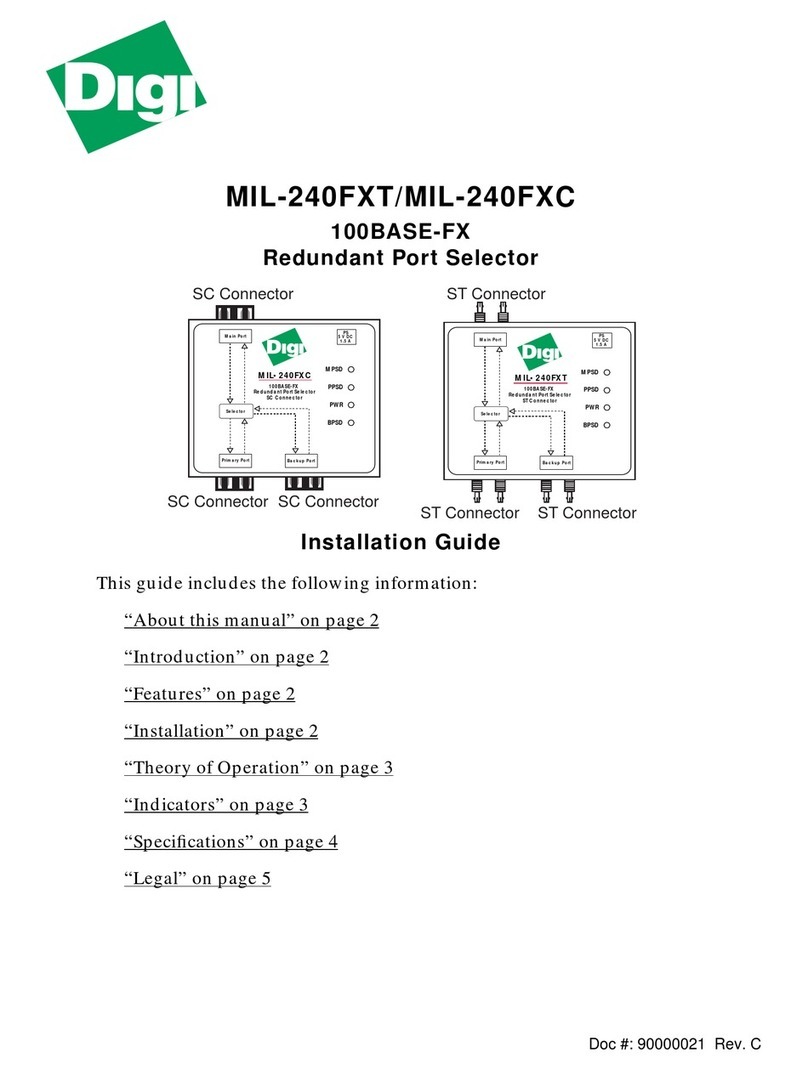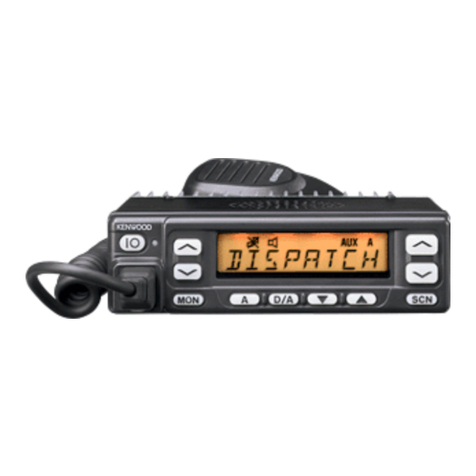II Morrow Inc. Apollo SL40 User manual

Apollo
Model SL40 VHF COMM Transceiver
Installation Manual
September 1999 560-0956-02a

1999 by II Morrow Inc. All rights reserved.
Printed in the USA
No part of this document may be transmitted, reproduced, or copied in any form or by any means
without the prior written consent of II Morrow Inc. Due to II Morrow’s commitment to
constantly improve the quality and performance of our products, information contained in this
document is subject to change without notice.
NAVNET and Flybrary are trademarks of II Morrow Inc.
II Morrow and Apollo are registered trademarks of II Morrow Inc.
II Morrow Inc. 2345 Turner Rd., SE
PO Box 13549 Salem, OR 97302
Salem, OR 97309 USA
Phone (503) 581-8101
1-800-525-6726
In Canada 1-800-654-3415
FAX (503) 364-2138

HISTORY OF REVISIONS
Revision Date Description
-- 12/18/96 Initial release.
00A 1/30/97 Modified selectivity value to 7 kHz.
-01 3/14/97 Change recommended coax from RG-58 to RG-142B
-02 6/26/98 New software version
-02a 9/22/99 Added new connector pins and crimping tools
IMPORTANT NOTE
“The conditions and tests required for TSO approval of this article are minimum performance
standards. It is the responsibility of those desiring to install this article on or within a specific
type or class of aircraft to determine that the aircraft operating conditions are within TSO
standards. The article may be installed only if further evaluation by the user/installer
documents an acceptable installation and is approved by the Administrator.”
Source: FAA TSO-C37d, TSO-C38d, and TSO-C128
ORDERING INFORMATION
To receive additional copies of this publication, order part # 560-0956-02a, Apollo SL40 VHF
COMM Installation Manual.

NOTES

Table of Contents
Apollo SL40 Installation Manual i
TABLE OF CONTENTS
SECTION 1 - INTRODUCTION.................................................................................................1
ABOUT THIS MANUAL......................................................................................................................1
APOLLO SL40 DESCRIPTION.............................................................................................................1
FEATURES.........................................................................................................................................1
REGULATORY COMPLIANCE .............................................................................................................2
UNPACKING THE EQUIPMENT............................................................................................................3
PACKAGE CONTENTS........................................................................................................................3
OTHER REQUIRED MATERIALS .........................................................................................................4
SPECIAL TOOLS REQUIRED ...............................................................................................................4
LICENSE REQUIREMENTS..................................................................................................................4
SECTION 2 - INSTALLATION..................................................................................................5
PRE-INSTALLATION INFORMATION....................................................................................................5
INSTALLATION OVERVIEW................................................................................................................5
INSTALLATION CONSIDERATIONS......................................................................................................5
MOUNTING CONSIDERATIONS....................................................................................................................................5
MINIMUM SYSTEM CONFIGURATION .........................................................................................................................5
EQUIPMENT MOUNTING....................................................................................................................5
ELECTRICAL CONNECTIONS..............................................................................................................7
POWER ......................................................................................................................................................................7
SPEAKER AND HEADPHONE OUTPUTS .......................................................................................................................7
MICROPHONE INPUTS................................................................................................................................................7
TRANSMIT KEY INPUT...............................................................................................................................................7
INTERCOM SELECTOR SWITCH ..................................................................................................................................7
SERIAL INTERFACE....................................................................................................................................................8
ANTENNA INSTALLATION AND CONNECTIONS ..................................................................................8
POST INSTALLATION CHECKOUT.....................................................................................................12
SECTION 3 - SPECIFICATIONS.............................................................................................15
ELECTRICAL ...................................................................................................................................15
PHYSICAL .......................................................................................................................................15
ENVIRONMENTAL ...........................................................................................................................15
RECEIVER PERFORMANCE...............................................................................................................16
TRANSMITTER PERFORMANCE........................................................................................................16
INTERCOM PERFORMANCE..............................................................................................................17
CONTROL INPUTS............................................................................................................................17
ANTENNA REQUIREMENTS..............................................................................................................17
SERIAL INTERFACE .........................................................................................................................17
REAR CONNECTOR PINOUT.............................................................................................................17
SECTION 4 - LIMITATIONS...................................................................................................19
INSTALLATION ................................................................................................................................19
OPERATIONAL ................................................................................................................................19
APPENDIX A - TROUBLESHOOTING..................................................................................21
CONTACTING THE FACTORY FOR ASSISTANCE................................................................................21

Table of Contents
ii Apollo SL40 Installation Manual
APPENDIX B - PERIODIC MAINTENANCE ....................................................................... 23
EQUIPMENT CALIBRATION ............................................................................................................. 23
REFERENCE OSCILLATOR.........................................................................................................................................23
CLEANING THE FRONT PANEL ........................................................................................................ 23
APPENDIX C - ENVIRONMENTAL QUALIFICATIONS.................................................. 25
APPENDIX E - SERIAL INTERFACE SPECIFICATIONS................................................. 27
RS-232 INPUTS .............................................................................................................................. 27
RS-232 OUTPUTS........................................................................................................................... 29
LIST OF TABLES
TABLE 1 PACKAGE CONTENTS........................................................................................................ 3
TABLE 2 CONNECTOR PINOUT....................................................................................................... 18
TABLE 3 TROUBLESHOOTING GUIDE............................................................................................. 21
LIST OF ILLUSTRATIONS
FIGURE 1 SL40 FRONT PANEL ........................................................................................................ 2
FIGURE 2 MOUNTING FRAME ASSEMBLY........................................................................................ 6
FIGURE 3 CABLE ROUTING.............................................................................................................. 6
FIGURE 4 COAX CONNECTOR ASSEMBLY........................................................................................ 9
FIGURE 5 SL40 STANDALONE WIRING DIAGRAM ......................................................................... 10
FIGURE 6 SL40 TYPICAL AUDIO PANEL CONNECTIONS ................................................................ 11
FIGURE 7 UNIT DIMENSIONS ......................................................................................................... 16

Introduction
Apollo SL40 Installation Manual 1
SECTION 1 - INTRODUCTION
ABOUT THIS MANUAL
This manual describes the installation of the Apollo SL40 Comm . It is intended for use by
persons certified by the Federal Aviation Administration (FAA) to install aircraft navigation
devices. It includes installation and checkout procedures for the SL40 unit to standards
described in FAA advisory circular AC 20-67B.
Provides an introduction to the Apollo SL40 unit. TSO certification information
is also included in this section.
Includes installation and checkout procedures.
Includes complete specifications.
Includes limitations for the equipment and installation.
Includes troubleshooting information.
Includes periodic maintenance requirements.
Includes the environmental qualification form.
Includes serial data specifications.
APOLLO SL40 DESCRIPTION
The Apollo SL40 is a 760 channel VHF Comm transceiver. It is one member of the Apollo
slimline series, which includes the SL40 Comm, the SL50 GPS, and the SL60 GPS/Comm.
FEATURES
The features of the SL40 Comm include:
•760 channels
•Frequency range of 118.000 to 136.975MHz
•Active and standby frequency display
•16 character high-intensity alphanumeric LED display
•Automatic display intensity
•Back-lit buttons
•Transmit status indicator
Section 1
Section 2
Section 3
Section 4
Appendix A
Appendix B
Appendix C
Appendix E

Introduction
2 Apollo SL40 Installation Manual
•Frequency memory and recall functions
−from remote source
−eight last used
−eight user stored
•Weather channels
•Frequency monitor function
•Built-in intercom function
•Stuck mic time-out
•Two microphone inputs
•Internal non-volatile memory - no battery required
•Full range input supply voltage
•12 watt audio amplifier
REGULATORY COMPLIANCE
The Apollo SL40 is designed and tested to meet the following TSOs:
FAA TSO-C37d for transmit
FAA TSO-C38d for receive
FAA TSO-C128 for unintentional transmission (stuck mic)
The Apollo SL40 complies with the FCC requirements specified in:
CFR 47, Part 87, Aviation Services, Subpart D, Technical Requirements
CFR 47, Part 15, Radio Frequency Devices, Subpart B, Unintentional Radiators
The Apollo SL40 software is designed and tested to RTCA/DO-178B, level C.
Figure 1 SL40 Front Panel

Introduction
Apollo SL40 Installation Manual 3
The Apollo SL40 meets the additional standards as detailed in the Declaration of Conformity
included on page 31.
Note: Unauthorized changes or modifications to the SL40 may void the compliance to
required regulatory agencies and authorization for continued equipment usage.
UNPACKING THE EQUIPMENT
Carefully unpack the equipment. Visually inspect the package contents for any evidence of
shipping damage. Retain all shipping containers and packaging material in case reshipment is
necessary.
PACKAGE CONTENTS
As shipped from the II Morrow factory, the Apollo SL40 package includes most necessary
items for installation other than supplies normally available at the installation shop, such as
wire and cable ties, and required input and output equipment. The items included in the
package are listed in Table 1.
Table 1 Package Contents
Part # Description Qty
Comm unit
430-6040-2xx Apollo SL40 Comm Transceiver 1
Apollo SL40 Installation Kit, Part # 424-2006-2xx
162-0100 or
162-1575 15 pin dsub connector shell 1
162-1008 Right angle coax plug 1
202-0001 Cable tie 2
204-2100 Shoulder bushing 2
221-0400 4-40 x 1/4 SS pan head Phillips machine screw with lock washer 8
224-0404 4-40 x 1/4 SS flat head Phillips machine screw 2
245-0022 or
245-0027 Crimp contact for dsub, 20 to 24 awg wire 15
310-5181-00 Mounting frame 1
310-5187-00 Connector mounting plate 1
998-0048 3/32 hex driver 1
204-0037 Edge grommet 6”
Apollo SL40 Manual Kit, Part # 564-0064-2xx
560-0954-xx SL40 User’s manual 1
560-0956-xx SL40 Installation manual 1

Introduction
4 Apollo SL40 Installation Manual
OTHER REQUIRED MATERIALS
The SL40 is intended for use with standard aviation accessories. The following items are
required for the installation:
•comm antenna with cables
•a microphone
•a speaker or headphone
These items may be installed dedicated to the SL40 comm or by connections to an audio
panel.
SPECIAL TOOLS REQUIRED
Crimp Tool
A crimp tool meeting MIL specification M22520/1-01 and a positioner/locater are required to
ensure consistent, reliable crimp contact connections for the rear d-sub connectors. These tools
are available from:
For pin p/n 245-0022
Astro Tool Corp. Phone (503) 642-9853
21615 SW TV Highway Fax (503) 591-7766
Beaverton, OR 97006
Crimp tool: Astro Tool part #615708
Positioner: Astro Tool part #616356
For pin p/n 245-0027
ITT Cannon Phone (714) 261-5300
1851 E. Deere Ave. Fax (714) 575-8324
Santa Ana, CA 92705-6500
Insertion tool: ITT part # 274-7006-000 (Desc. CIET-20HD)
Regular duty Crimp tool: ITT part #995-0001-585 (Desc. M22520/1-01)
Regular duty Locator tool: ITT part #995-0001-244 (Desc. TH25)
Heavy duty Crimp tool: ITT part #995-0001-584 (Desc. M22520/2-01)
Heavy duty Locator tool: ITT part #995-0001-604 (Desc. M22520/2-08)
LICENSE REQUIREMENTS
An aircraft radio station license is required for operation of the transmitter once installed in
the aircraft. An application must be submitted on FCC Form 404, which may be obtained
from the FCC in Washington, DC, or any of its field offices. Procedures for applications are in
CFR 47, Part 87, Aviation Services, Subpart B, Applications and Licenses.

Installation
Apollo SL40 Installation Manual 5
SECTION 2 - INSTALLATION
This section describes the installation of the Apollo SL40 including mounting, wiring, and
connections. A post installation check-out procedure is included at the end of this section.
PRE-INSTALLATION INFORMATION
Always follow good avionics installation practices per FAA Advisory Circulars (AC) 43.13-
1A, 43.13-2A, and AC 20-67B, or later FAA approved revisions of these documents.
Follow the installation procedure in this section as it is presented for a successful installation.
Read the entire section before beginning the procedure. Perform the post installation check-
out before closing the work area in case problems occur.
INSTALLATION OVERVIEW
A successful installation should start with careful planning including determination of
mounting location for the SL40, antenna mounting, connections to microphones, speakers,
and headphones, cable routing, and other required modifications. Once the mounting location
has been determined, prepare the mounting frame for installation. It may be easier to complete
the wiring harness and attach the connectors to the mounting frame before installing the
mounting frame.
INSTALLATION CONSIDERATIONS
MOUNTING CONSIDERATIONS
The SL40 is designed to mount in the avionics stack in the aircraft instrument panel within
easy view and reach of the pilot. The standard package includes a mounting frame for ease of
mounting, connections, and service of the unit. Allow an additional one inch clearance to the
rear of the mounting frame for connectors and cables.
For typical installations, the SL40 does not require external cooling. When mounting the
SL40, leave a clearance of 1/8 to 1/4 inch between avionics to allow for circulation.
MINIMUM SYSTEM CONFIGURATION
The SL40 requires connections to the following equipment as a minimum:
•power input
•speaker or headphone output
•microphone input
•an antenna
EQUIPMENT MOUNTING
Once the cable assemblies have been made, attach the 15 pin dsub and coaxial cable
connectors to the rear connector mounting plate and the mounting frame as illustrated in
Figure 2 and Figure 3. Route the wiring bundle as appropriate. The rear connector plate should
be attached to the mounting frame before installing the frame in the instrument panel. The rear
connector plate can be used to tie down the cable assemblies. Connect the shield grounds
directly to the connector mounting plate.

Installation
6 Apollo SL40 Installation Manual
Once the cable assemblies are complete and the connectors are attached to the mounting
frame, install the mounting frame assembly in the instrument panel. Be sure to use low profile
Figure 2 Mounting Frame Assembly
Figure 3 Cable Routing

Installation
Apollo SL40 Installation Manual 7
head screws so the unit will slide in and out freely. Attach the front of the mounting frame to
the instrument panel. Use support brackets to attach the rear of the frame to the aircraft.
To install the unit in the mounting frame, make sure the cam lock is rotated so the rear part is
up, then slide the unit into the frame and tighten with the 3/32 hex tool. The unit will be
pulled into the frame by the cam lock and the connectors will fully engage.
To remove the unit from the mounting frame, use the hex tool and turn the tool CCW. The
unit will be pushed out of the frame by the cam lock assembly. No special extraction tools are
required.
ELECTRICAL CONNECTIONS
The SL40 installation kit includes a 15 pin dsub shell and crimp contacts. The crimp contacts
are specified for 20 to 24 AWG wire. Make the crimp connections with a crimp tool as
specified in the Special Tools Required section on page 4. All wires should be 20 to 24 AWG
unless otherwise specified. A wiring diagram is included as Figure 5.
POWER
The SL40 is internally fused at 7 amps. A separate 5 amp (maximum) circuit breaker or fuse
should be installed for downline overload or short circuit protection. Make the power
connections to the SL40 using 20 awg wire.
Note: Circuits should be protected in accordance with guidelines in AC 43.13-1A, chapter 11,
section 2, paragraph 429.
SPEAKER AND HEADPHONE OUTPUTS
Connect the speaker and headphones to the output pins on the rear connector.
MICROPHONE INPUTS
Microphone input connections should be made using a twisted pair shielded cable. Attach the
signal ground to the mic ground pin on the rear connector and connect the shield to the rear
connector plate.
TRANSMIT KEY INPUT
The TxKey input on the rear connector must be pulled low to ground to enable the transmitter.
This input should be connected to a microphone or yoke mounted momentary push button
switch.
INTERCOM SELECTOR SWITCH
The SL40 includes an intercom function that can be enabled by an external control switch.
This is an optional connection.
When making connection for the intercom selection, connect the intercom selection input to a
remote mounted normally open switch. A momentary toggle or alternate action switch can be
used. Connect the other terminal of the switch to ground. The intercom function is enabled
when the input is pulled low to ground.

Installation
8 Apollo SL40 Installation Manual
SERIAL INTERFACE
The SL40 includes an RS232 serial port, which can be used for inputting frequency and
function control commands and outputting transceiver status. This is an optional connection.
When making serial connections to the SL40, use a shielded three conductor cable. Make the
RxD, TxD, and ground connections on the 15 pin connector. Connect the shield to the rear of
the mounting frame on the connector plate.
The SL40 can be connected to the RS-232 serial data outputs on the Apollo 2001GPS
(requires software version 5.1 or later), the SL50, SL60, GX50, GX55, GX60, or the 360
Map/GPS for receiving remote frequency information from the GPS navigation data base.
Refer to the installation manuals for those units for connections and serial data output
selections.
Complete serial interface specifications are included in Appendix E.
ANTENNA INSTALLATION AND CONNECTIONS
The SL40 requires a standard 50Ωvertically polarized antenna. Follow the antenna
manufacturer’s installation instructions for mounting the antenna.
The antenna should be mounted on a metal surface or a ground plane with a minimum area of
18 x 18 inches. The antenna should be mounted a minimum of 24 inches away from GPS
antennas.
The comm antenna should also be mounted as far apart as practical from the ELT antenna,
preferably one on top and the other on the bottom of the aircraft fuselage. Some ELTs have
exhibited re-radiation problems generating harmonics that may interfere with GPS signals.
This can happen when the comm (SL40 or any other comm) is transmitting on certain
frequencies such as 121.15 or 121.175 MHz, which may cause the ELT output circuit to
oscillate from the signal coming in on the ELT antenna coax.
The antenna coax cable should be made of RG-142B or a comparable quality 50Ωcoax.
Assembly instructions for the rear coax connector are included in Figure 4.

Installation
Apollo SL40 Installation Manual 9
Slit 1/4" (2X)
Clamp Nut
0.375
0.031
- Slide clamp nut over coax.
- Strip coax as illustrated.
- Cut two 1/4" slits in jacket 180
degrees apart.
Braid Clamp
Cap
Solder Center
Conductor
Step 1.
Step 2.
Step 3.
- Slide braid clamp over end of coax and
under the braid.
- Insert coax with braid clamp into
connector and tighten clamp nut securely.
- Solder the center conductor of the coax
to the contact as illustrated.
- Attach the cap and secure tightly.
Assembly instructions for right angle connector part #162-1008
0.125
Figure 4 Coax Connector Assembly

Installation
10 Apollo SL40 Installation Manual
Figure 5 SL40 Standalone Wiring Diagram

Installation
Apollo SL40 Installation Manual 11
Figure 6 SL40 Typical Audio Panel Connections

Installation
12 Apollo SL40 Installation Manual
POST INSTALLATION CHECKOUT
Once the unit is installed, complete the checkout procedure to verify proper operation. Refer
to the User’s Guide for operating instructions.
Mounting / Wiring Check
Verify that all cables are properly secured and shields are connected to the rear of the
mounting frame. Check the movement of the aircraft controls to verify that there is no
interference.
Receiver / Transmitter Operation
Tune the unit to a local frequency and verify the receiver output produces a clear and
understandable audio output. Verify the transmitter by contacting another station and getting a
report of reliable communications.
Antenna Check
The antenna VSWR can be checked using an inline watt meter in the antenna coax using
frequencies near both ends of the band. The VSWR should be < 2:1, and is not to exceed 3:1.
A VSWR of 2:1 will cause a drop in output power of approximately 12%, and 3:1 causes
approximately a 26% drop.
Interference Check
Check the SL40 while operating the other avionics and electrical systems on the aircraft to
verify that no significant interference exists, and that the SL40 does not cause significant
interference with other systems. Performance should be checked using low, high, and mid
band frequencies. Repeat during the flight test for equipment that is not checked on the
ground.
Sidetone Level Adjustment
The sidetone volume was preset at the factory to what should be an acceptable level. The level
can be adjusted in the System Functions mode. To adjust the sidetone level:
1. Press and hold the MON button for about two seconds. This will access the System
Functions mode.
2. Rotate the LARGE knob to display the SIDETONE LVL page.
3. Rotate the SMALL knob to change the level number. The range of the number is 000 to
255, with 128 producing one half of full rated output. A setting of 000 slaves the level to
the Volume knob.
4. Press any key to exit the Setup Functions mode.
5. Select an appropriate frequency, key the transmitter, and talk into the microphone to check
the level.
Receiver Squelch Adjustment
Adjustments to the receiver squelch level may be performed by using the RCVR SQELCH page
in the Test Mode. Values may be adjusted between 25 and 100.
1. Press and hold the ⇔and RCL keys while switching the unit on.
2. Turn the LARGE knob to the RCVR SQELCH page.
3. Press the ⇔key to start selection (the number will flash).
4. Turn the SMALL knob to change the value. Press MEM to store the value.

Installation
Apollo SL40 Installation Manual 13
5. Turn the unit off to exit the Test Mode.
Mic Level Adjustment
Those units with audio board p/n 415-7008-01, or later, have the ability to make adjustments
to microphone sensitivity by using the MIC 1 LEVEL and MIC 2 LEVEL pages in the Test
Mode.
1. Press and hold the ⇔and RCL keys while switching the unit on.
2. Turn the LARGE knob to the MIC 1 LEVEL and MIC 2 LEVEL pages.
3. Press the ⇔key to start selection (the number will flash).
4. Turn the SMALL knob to change the value. Press MEM to store the value.
5. Turn the unit off to exit the Test Mode.
Display Test
It is possible to perform a simple test to observe all segments of the display for a quick
checkout of the display functions.
1. Press and hold the ⇔and RCL keys while switching the unit on.
2. Turn the LARGE knob to the DISPLAY TEST page.
3. Press MEM to perform the test. A series of “#” symbols will advance across the display
testing each LED.
4. Turn the unit off to exit the Test Mode.
Mic Squelch
Adjustments to the squelch levels for Mic1 and Mic2 are available in the System Functions
mode. To adjust the Microphone Squelch level:
1. Press and hold the MON button for about two seconds. This will access the System
Functions mode.
2. Rotate the LARGE knob to display the MIC1 OR MIC2 SQLCH pages.
3. Rotate the SMALL knob to change the level number. The range of the number is 000 to
127.
4. Press any key to exit the Setup Functions mode.
5. Select an appropriate frequency, key the transmitter, and talk into the microphone to check
the level.
Transmit Mic
The Transmit Microphone page allows you to control which microphone is permitted to
transmit. You may choose Mic 1, 2, or both. To adjust the Transmit Mic control:
1. Press and hold the MON button for about two seconds. This will access the System
Functions mode.
2. Rotate the LARGE knob to display the TRANSMIT MIC page.
3. Rotate the SMALL knob to select MIC1, MIC2, or MIC1+MIC2.
4. Press any key to exit the Setup Functions mode.
5. Select an appropriate frequency, key the transmitter, and talk into the microphones to
check for the intended operation.

Installation
14 Apollo SL40 Installation Manual
Flight Test Check
A flight test is recommended as a final installation verification. The performance may be
verified by contacting a ground station at a range of at least 50 nm while maintaining an
appropriate altitude and over all normal flight attitudes. Performance should be checked using
low, high, and mid band frequencies.
Other manuals for Apollo SL40
1
Table of contents
Other II Morrow Inc. Transceiver manuals
Popular Transceiver manuals by other brands

Mizuho
Mizuho MX-2 Operating & assembly instruction

Siemens
Siemens PSO 4000 Quick reference guide
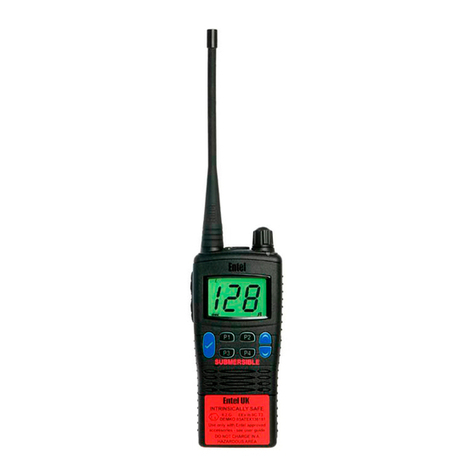
Entel
Entel HT920 owner's manual
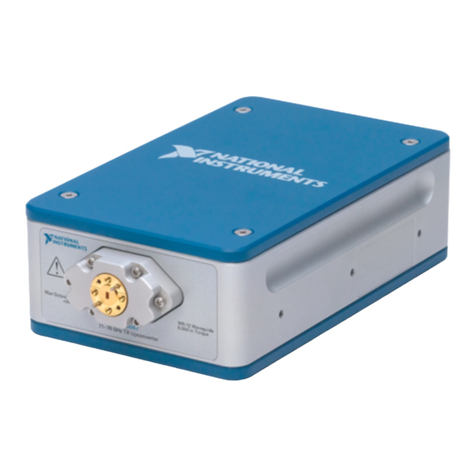
National Instruments
National Instruments PXIe-3610 Getting started guide
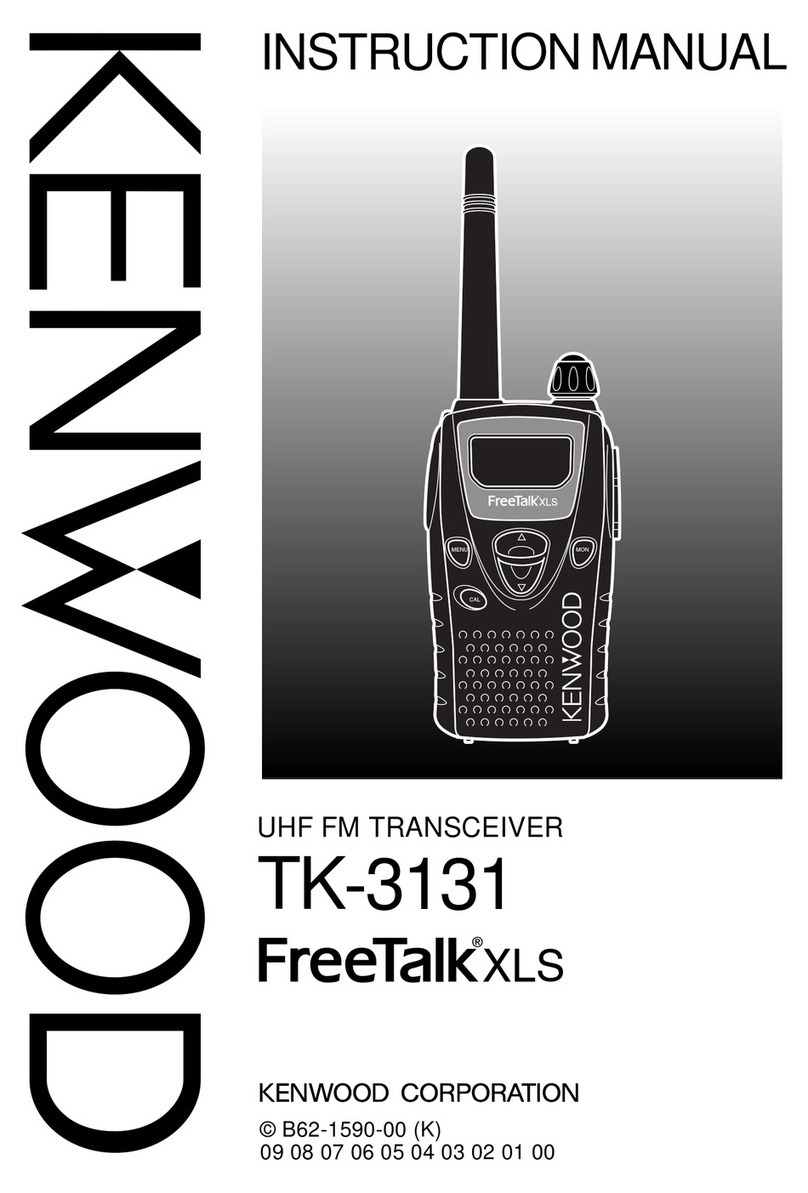
Kenwood
Kenwood TK-3131 - FreeTalk XLS FRS/GMRS instruction manual
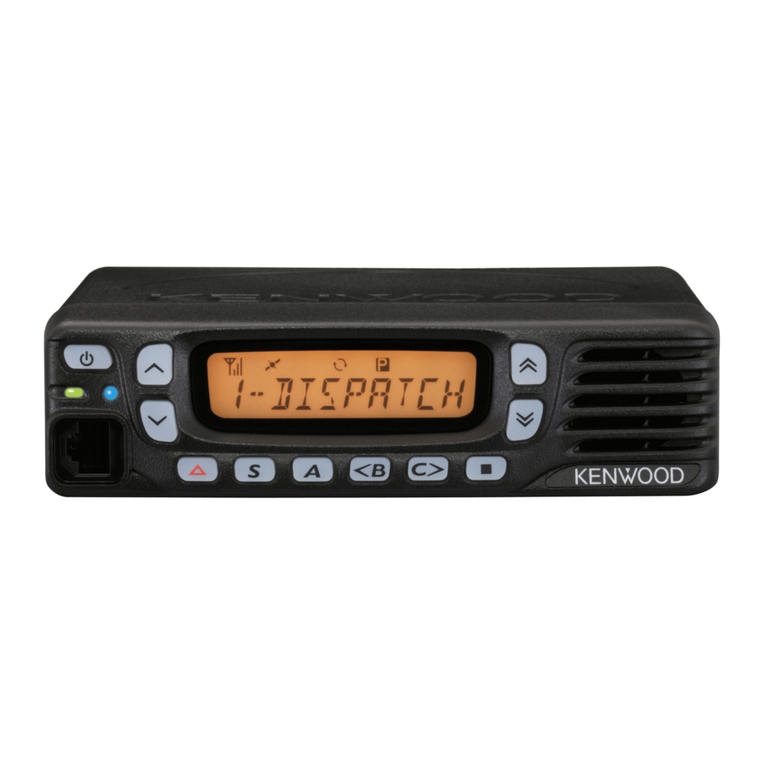
Kenwood
Kenwood TK-7180 Service manual
